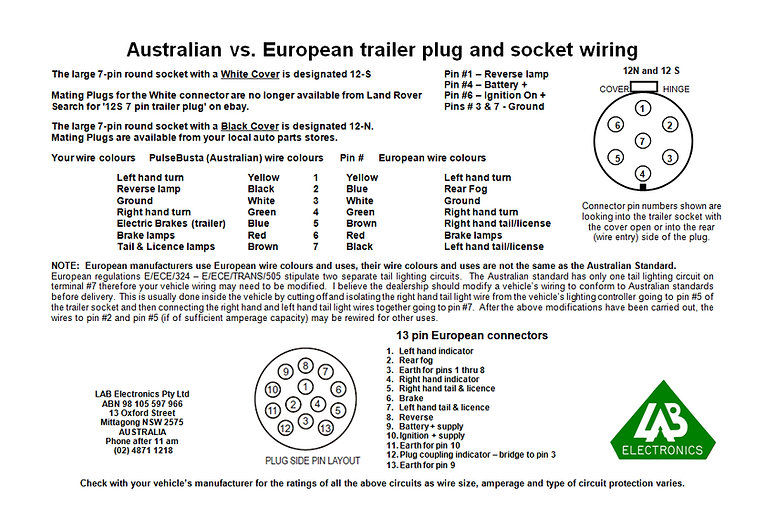Busta 4 Internal
Busta 4.2 – Fitting Instructions for internal ‘trailer mounting’
Compatibility:
- Busta 4.2 is suitable for all 12-volt negative earth towing vehicles in compliance with European lighting regulations.
- It’s designed for trailers with a single tail/license plate lighting circuit and no need for monitoring turn signal LEDs.
- Note: Any vehicle can tow a trailer with Busta 4.2 installed.
Installation Precautions:
- Do not install Busta 4.2 on the towing vehicle, as it will mistakenly detect a connected trailer.
- Carefully read all instructions. Seek assistance if needed.
- Prepare all tools and materials before starting.
Wiring Details:
- Busta 4.2 includes a 600mm long (2ft) 7-core cable rated at 10 amps per wire.
- Wire colors: Yellow (left turn), Green (right turn), Red (brake light), Brown (park/license plate light), White (earth).
- Each LED driver circuit can handle up to 4 amps. Do not connect light bulbs to the trailer’s LED driver circuits.
- Identify and record your trailer’s wire uses and colors on the provided plug and socket wiring page.
Mounting:
- Choose a well-ventilated location for Busta 4.2. Avoid heat-sensitive materials.
- Suitable locations include under a bench seat, in the trailer’s electrical box, or a similar uncluttered area.
Installation Steps:
- Disconnect the trailer from the vehicle and disable any power sources in the trailer.
- For the trailer LEDs:
- Connect the trailer’s earth wire to the White wire from Busta 4.2.
- Connect the left turn signal wire to the Yellow output wire.
- Connect the right turn signal wire to the Green output wire.
- Connect the brake light wire to the Red output wire.
- Connect the tail/license plate wire to the Brown output wire.
- Solder each connection.
- For the vehicle end of Busta 4.2:
- Connect the trailer’s earth wire to the White wire.
- Connect the left turn signal wire to the Yellow input wire.
- Connect the right turn signal wire to the Green input wire.
- Connect the brake light wire to the Red input wire.
- Connect the tail/license plate wire to the Brown input wire.
- Solder each connection.
- If you have unconnected wires (Black and Blue), either cut them back if not needed or connect them to the remaining wires in your trailer cable as required.
Follow these steps carefully to ensure a successful installation of Busta 4.2 for your trailer lighting needs.
Testing Trailer LED Lights
Step 1: Prepare for Testing
- Ensure all soldered connections are separated and not touching any metal parts of the trailer.
- Reconnect power sources in the trailer.
- Make sure the vehicle’s ignition and lights are switched off.
- Connect the trailer to the vehicle.
Step 2: Check LED Lights
- Turn on the vehicle’s ignition.
- Verify that any previously blinking trailer LEDs have stopped.
- Ensure the trailer indicator works with turn and hazard signals.
- Start the engine, switch on the park lights, and test the foot brake to check all LEDs.
- Ensure there are no lamp failure warnings. Refer to the last page for troubleshooting if needed.
- Once all trailer LEDs are working correctly, switch everything off.
Step 3: Secure Solder Connections
- Insulate and seal the cable ends to prevent liquid and dust entry.
- Apply a small amount of silicone sealant to all open ends of the cable outer sheaths.
- Push the sealant around the wires using a small screwdriver.
- Add an outer seal of self-amalgamating tape and/or heatshrink tape to completely seal the joins.
- Ensure the cable is securely attached to the trailer where necessary.
Important Note
- Always connect and disconnect the trailer with the vehicle’s ignition and lights switched off.
- Connecting or disconnecting with the vehicle’s ignition and/or lights on can cause malfunctions or unintended operation by some vehicle computer systems.
PulseBusta MK4 Installation
What You’ll Need:
- Tools: You’ll require a PulseBusta MK4, various hand and power tools, a test light, soldering iron, and solder.
- Mounting Supplies: Gather self-taping screws, regular screws, nuts, washers, ‘pop’ rivets, ‘P’ clips, or any other fixtures needed for attaching the PulseBusta and connecting the cable to the trailer.
- Electrical Components: Acquire terminal blocks, insulated terminals or plugs, sockets with crimp terminals, and other necessary electrical components.
- Insulating Materials: Ensure you have electrical insulating tape, silicone sealant, heat shrink tubing, self-amalgamating tape, liquid electrical tape, or similar materials for insulation and protection.
Important Information:
- The PulseBusta MK4 comes with a two-year warranty covering defects in parts and manufacturing. It is sealed to an IP-68 rating, but this warranty does not extend to corrosion or damage caused by liquid or dust after operation begins.
- Regularly inspect the assembly for potential entry points for liquids and dust, such as nicks, cuts, or abrasions. Seal any openings with silicone sealant to prevent corrosion of wires and electronics.
- If the PulseBusta MK4 requires servicing or assessment, please return it to LAB Electronics. There are no user-serviceable components inside.
- Note that the PulseBusta MK4 does not conform to E/ECE/324 – E/ECE/TRANS/505 regulations, as it does not monitor the trailer’s turn signal LEDs. Therefore, it cannot indicate faults by turning off the trailer telltale in the instrument cluster. It remains the driver’s responsibility to ensure that all vehicle and trailer lighting functions correctly.
A trailer lamp failure warning
Troubleshooting Trailer Lamp Warning
Overview:
If you encounter a trailer lamp failure warning in your vehicle when using park and stop lights with a trailer, follow these steps to resolve the issue.
Instructions:
- Background Information:
- The lamp check modules in most vehicles can’t check a trailer’s park and stop LED circuits.
- The internal load resistors in the PulseBusta Mk4 and Euro units are present but unconnected because they generate unnecessary heat and power consumption.
- Troubleshooting Steps:
- If you receive a trailer lamp failure warning, follow these steps carefully:
- Grip the 19mm (3/4in) body nut of the cable gland with a THIN spanner.
- Loosen the tail with another 19mm (3/4in) spanner.
- Once loosened, undo the tail by hand and slide it along the cable away from the body.
- Remove the black silicone sealant from the two screw holes in the trailer end plate.
- Remove the two screws from the end plate and check the O-ring seals.
- Carefully move the end plate along the cable to access the rubber seal.
- Check the sealing gasket on the end plate for damage.
- Locate three insulated wires with pre-stripped ends inside the unit.
- The White wire is the earth wire.
- The Black wire is for the park circuit load resistor(s).
- The Red wire is for the stop circuit load resistors.
- If you have a lamp failure warning only on the trailer park circuit, connect the Black wire to the White wire.
- If you have a lamp failure warning only on the trailer stop circuit, connect the Red wire to the White wire.
- If you have a lamp failure warning on both circuits, connect all three wires together.
- Unscrew the end cap from the White wire and remove the sleeve from the Red and/or Black wires.
- Twist the required wires together and screw the end cap from the White wire over them.
- Apply a small amount of neutral cure silicone sealant around the end plate gasket.
- Reattach the end plate using the original screws (ensure O-rings are in place).
- Apply black silicone sealant to cover the screw heads as they were originally sealed.
- Slide the rubber seal along the cable and into the cable gland.
- Hand-tighten the tail onto the cable gland using two 19mm (3/4in) spanners to avoid damaging the seal.
By following these steps, you can resolve the trailer lamp failure warning and ensure your trailer’s lights function properly. If you’re unsure about performing these operations, seek assistance from someone experienced.


